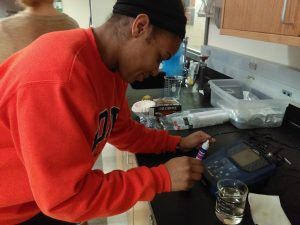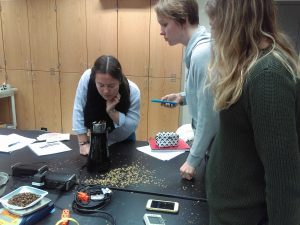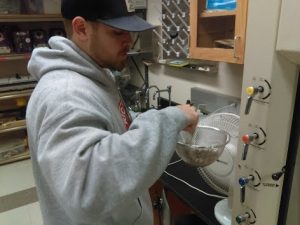It’s the second-leading commodity traded in the world after oil, with a worldwide consumption of 2.2 billion cups per day. And, the United States is its leading consumer at 400 million cups daily. Yet, few people are aware of the scientific, political, historical and cultural implications swirling inside their cup of morning joe.
This is not the case for Hope students who take Dr. Tom Bultman’s new class, The Science and Culture of Coffee. They are getting a thoroughly flavorful education about everything they ever needed or wanted to know about coffee.
True scientific experiments are conducted using coffee as the vehicle to construct hypotheses, make predictions, collect data and evaluate outcomes.

Offered for the first time this spring, Bultman’s two-credit coffee course is just one of two of its kind taught at colleges and universities in the U.S. as far as he can tell (the other is offered at UC-Davis). While there are dozens of barista schools in the country that teach their students how to roast, grind and brew the perfect cup of coffee, this new class for college credit goes much deeper than that. True scientific experiments are conducted using coffee as the vehicle to construct hypotheses, make predictions, collect data and evaluate outcomes. How do acidity levels change in beans due to varying roasting times? What happens to the mass transfer of water and grounds during the brewing process? What is the anatomy of a coffee cherry fruit and how are beans harvested from within?
There are history lessons, too, about the global trade of the Coffea arabica beans and bush — a plant native to Ethiopia that helped create early agricultural routes throughout the sub-tropical world. Bultman, a professor of biology, also covers ground on the way coffee affects national economies, personal health and policies on fair trade and human rights. And knowing how much college students love their coffee for its social and caffeinated benefits, Bultman’s course is listed under Hope’s General Education Math and Science offerings which target non-science majors. It’s gives its pupils one truly eye-opening experience.
“This class has definitely increased my appreciation of coffee, especially in the roasting of it,” says sophomore Sarah Kalthoff of Carmel, Indiana. “I see all of the work and love that goes into the process. Coffee really brings people together throughout the world and I now recognized that when I go to a coffee shop here. So many people around the world — farmers, families, fair traders — are affected by the cup of coffee I’m drinking so it’s been great to see how coffee brings cultures together.”

Students in the class roast green coffee beans nine times during its half-semester schedule, using makeshift roasters that consist of an air popcorn popper, a tin can, and a small cooking thermometer. As the chaff from the beans pops like confetti from the contraptions’ tops during the roasting process, the lab becomes the best smelling classroom on campus. Students monitor the time, temperature, color and odor of the beans. Then later, they’ll brew and drink their roasted creations, experiencing the process of “cupping” to learn to how to discern and evaluate the taste of flavor notes — chocolate, butterscotch, molasses, raisin, for example — that are subtle but evident in good beans.

As if getting free morning coffee isn’t benefit enough (the course is offered at 9:30 am on Tuesday and Thursdays), Bultman even sets aside a class period for his students to learn how to create their own coffee mug in Hope’s ceramics studio under the guest tutelage of art professor Billy Mayer. Field trips to area businesses that roast and retail are also on the course syllabus.
Not surprisingly, this class on coffee has grown in popularity quickly. It’s been full to the brim each time it’s been offered (twice thus far) and the buzz around campus is that more students are clamoring to get in.
In this class, because all of us drink coffee, the knowledge is applicable to us. And we’re taking a class we’d never expect to take in college. This class to me is the definition of a liberal arts education.”
“It’s been a blast,” say the middle-aged Bultman who took up drinking coffee just three years ago and now admits to being a coffee geek. “Everyone who enrolls drinks coffee so it means something to them. And so many students don’t think about where coffee comes from or how it’s grown or brewed, it’s just one of those things we easily take for granted. Now they are more appreciative of all the work that goes into coffee before they sit down and drink a cup.”
“I technically didn’t have to take this class because all of my science requirements were done but when I saw the poster about it, I knew I had to take it,” comments junior communication major Sarah Gallagher of Chicago, Illinois. “A lot of college students who are not science majors say science and math classes are impractical to their lives but in this class, because all of us drink coffee, the knowledge is applicable to us. And we’re taking a class we’d never expect to take in college. This class to me is the definition of a liberal arts education.”


This makes me more excited than ever to attend Hope next year! Drinking coffee is one of my favorite pastimes and never fails to bring my friends and I closer. Now, there’s an opportunity to learn about it too?! That’s just too cool:)
Sarah,
Glad to hear you’re coming to Hope. Maybe I’ll see you in class next year!
Dr. B.